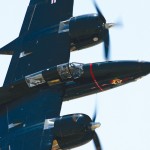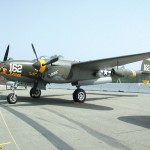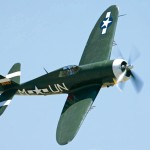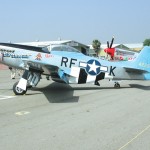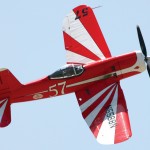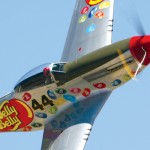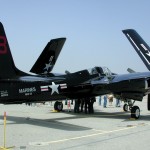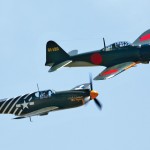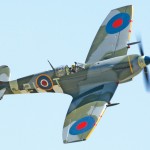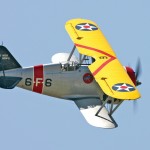By Larry W. Bledsoe
What makes an air show great? Is it the planes, the location, the people, the vendors—or all of these? The annual Planes of Fame Airshow at Chino, Calif., is rich in history and is the top warbird air show on the West Coast. Only at EAA AirVenture Oshkosh or the Commemorative Air Force’s AIRSHO in Midland, Texas, will you find more warbirds where they belong—in the air.
For more than four decades, Chino Airport has been a major warbird aircraft restoration center. Today it’s the home of two first class warbird museums, Planes of Fame and Yanks Air Museum. Another major aircraft restoration facility that remains on the field is Carl Scholl’s Aero Trader.
The air show, held this year May 20-21, had plenty of warbirds from WWI aircraft to today’s frontline fighters, F16 Vipers and F-18 Hornets, in addition to the numerous Mustangs, Hellcats and other WWII vintage aircraft. You get to see these planes up close, and for the true aircraft buff, you also get the sights and sounds as they make numerous flybys.
Before the show, the audience was treated to some warm-up flybys by several aircraft, including a formation of four L-19 liaison planes and a couple of Mustangs. As the National anthem was being sung, the audience witnessed a formation flyby with a P-26 Peashooter in the lead, a P-51 on its left wing and a Seversky AT-12 on the other. A North American F-86 Sabre filled in the fourth position.
As the Peashooter and the AT-12 made several passes, flying on a circuit below them was a red Fokker Dr.1 triplane and a Sopwith Camel. Both planes made slow passes, with the steady pop of the triplane’s throttled-back engine in contrast to the intermittent silence of the Camel’s engine whenever the pilot hit the interrupt button to slow the plane down.
The only flying Grumman F3F, the Navy’s last shipboard biplane fighter prior to WWII, soon joined the steady flyby. A gaggle of World War II aircraft—Mustangs, Wildcats, Hellcats and a Japanese Zero—followed these planes. This flight of 10 or more planes included the sleek F7F Tigercat in Marine Corps paint scheme of that era.

Planes of Fame’s B-25, Photo Fanny, is frequently used in movies and television and as a camera platform.
In addition to the numerous Mustangs, which included a rare “A” model, a Spitfire Mk.IX, a Sea Fury, P47s, a P-40, a P-63, F4F Wildcats, F6F Hellcats, F8F Bearcats and F4U Corsairs all would fly sometime during the show. Also displayed at the show were a couple of B-25s and a B-17. Among the most unusual aircraft were the Northrop N9MB flying wing and a Bell P-59 Airacomet. The P-59, America’s first jet fighter aircraft, is in the process of being restored to flying condition. Another rare jet was a beautiful red Folland Gnat.
The Inland Empire Wing of the CAF had three aircraft on hand, an L-4 (the military version of the Piper Cub), a Ryan PT-22 trainer and a newly restored C-53 (the paratrooper version of the DC-3). The C-53 was at its first air show away from its home base after four years of restoration.
Antique and classic cars in primo condition were on display. There was also a sizable contingency from the California Historical Group in World War II U.S., British, German and Russian uniforms eagerly ready to share with any listener information about the equipment and weapons of that period that they had on display.
Vendors sold items including hats, pins and T-shirts. The Planes of Fame booth had two authors signing copies of their books, “Adventures of a P-38 Ace,” by Col. Herbert E. Ross, and “An Innocent at Polebrook, a Memoir of an 8th Air Force Bombardier,” by Charles N. Stevens. Artists in attendance included Lonnie Ortega and Chris Rios, as well as Terri Polley and her twin sister Jerri Bergen, who do nose art on jackets, planes, walls and hunks of metal.
This annual show is not the oldest but is probably the longest running air show in Southern California. So why is it so successful? As one veteran vendor put it, “People know this is a pure aircraft show with lots of flying.”
- Mike Brown pilots this Grumman F7F-3P Tigercat, Big Bossman.
- Skidoo is a beautifully restored P-38.
- John Maloney is the pilot of Spirit of Atlantic City, a 1942 Republic P-47D Razor Back Thunderbolt painted in the markings of American ace Bud Mahurin’s P-47D-5.
- These two 51Ds, Six Shooter and Sparky (in the background), were just two of the half-dozen or so Mustangs at the air show.
- Bob Odegaard passes over the crowd in his 1947 Goodyear F2G-1 Super Corsair.
- Brant Seghetti flies Sparky, a 1944 North American P-51 D-25NA Mustang.
- This sleek Grumman F7F-3N TigerCat, in markings used by the Marines, is a magnificent sight in flight.
- A 1944 Mitsubishi A6M5 Zero piloted by John Maloney shares the moment with a 1943 North American P-51A-10NA Mustang, Mrs. Virginia, piloted by John Hinton.
- Aero Trader’s B-25J, Pacific Princess, has been used in movies and is one of the few B-25s to have ever been launched from a carrier deck.
- Chris Fahey flies this 1944 Supermarine Spitfire Mk.9.
- L to R: Mike Polley, Terri Polley, Chris Bergen and Jerri Bergen pose with mannequin “Dubious Dolly.” Artists Terri Polley and her twin sister Jerri Bergen are the principals of Victory-Girl, a company that specialize in nose art.
- As the war raged in Europe, the Grumman F3F-2 was the U.S. Navy and Marine Corps frontline fighter until the spring of 1941. This 1938 Grumman F3F-2, piloted by Rob Patterson, fittingly bears the name of the Flying Barrel.
- John Maloney adeptly pilots the 1940 Seversky AT-12 Guardsman.














